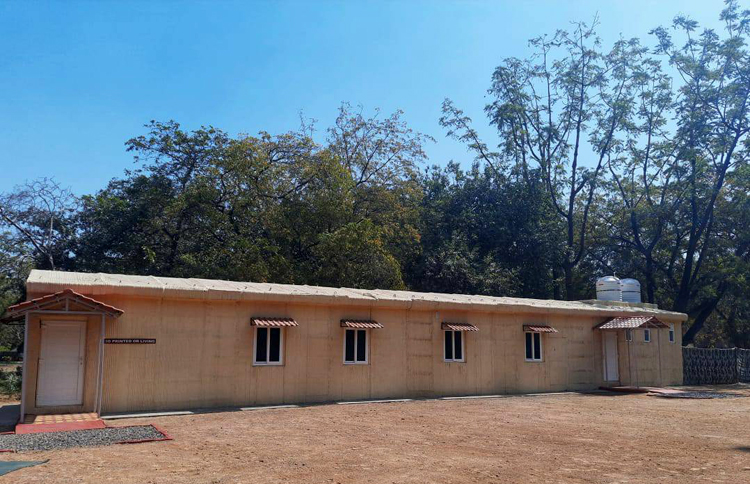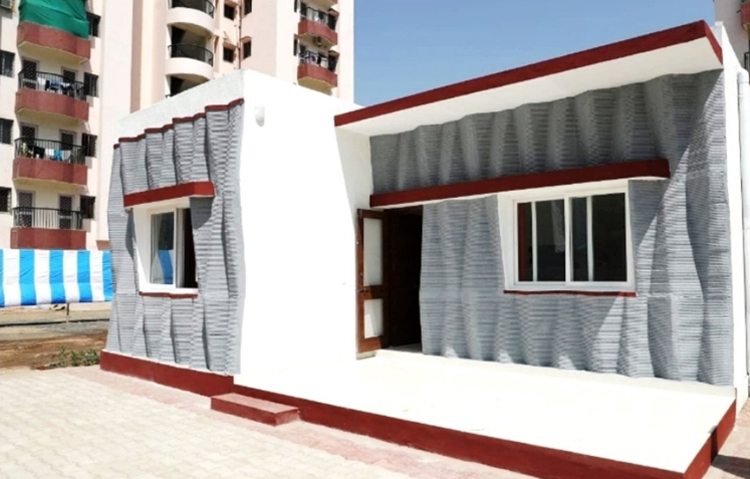INDIAN ARMED FORCES CHIEFS ON
OUR RELENTLESS AND FOCUSED PUBLISHING EFFORTS

SP Guide Publications puts forth a well compiled articulation of issues, pursuits and accomplishments of the Indian Army, over the years

I am confident that SP Guide Publications would continue to inform, inspire and influence.

My compliments to SP Guide Publications for informative and credible reportage on contemporary aerospace issues over the past six decades.
- Interim Defence Budget 2024-25 — An Analysis
- Union Defence budget 2024
- Indian Army: In quest of greater firepower and policy recommendations for gaps
- Indian Army Annual Press Conference 2024
- 6G will transform military-industrial applications
- Tata Boeing Aerospace Delivers 250 AH-64 Apache Fuselages, Manufactured in India
3D Printed Defence Works
The Indian Army is perhaps the first one to create permanent defences using 3D technology and has conducted successful trials
 |
The Author is Former Director General of Information Systems and A Special Forces Veteran, Indian Army |

The Indian Army plans to construct 'permanent defences' along the Line of Actual Control (LAC) in eastern Ladakh using cutting-edge 3D printing technology. With the continuing India-China standoff since April-May 2020, the Army has taken a number of steps to boost its capability development and achieve modernisation. After the Galwan Clash in June 2020, shelters for 22,000 troops and storing equipment have been constructed in Eastern Ladakh over the last two years.
The good news is that the Army has conducted successful trial of permanent defences using 3D printing technology. 3D printing technology uses complex software and robotic unit that helps in creating a structure through multiple stages from a digital model.
According to Lt General Harpal Singh, Engineer-in-Chief, these trials of 3D 'permanent defences' were successfully carried out against a range of weapons from small arms to the main gun of the T-90 tank; the 3D-printed permanent defences withstood direct fire by a T-90 tank from a distance of about 100 metres. These 3D structures are modern, compact, and can be lifted and erected in a few days. Most importantly, erecting these defences saves time, cuts costs and they can also be “relocated”.
Trials of 3D 'permanent defences' were successfully carried out against a range of weapons from small arms to the main gun of the T-90 tank
There have been many instances globally of the use of 3D printing for making firearms (termed ‘ghost guns’) and accessories. 3D-printed firearms can include handguns, rifles and machineguns. There are also modular or hybrid guns made from interchangeable firearm components (3D-printed or otherwise). This allows for customisation and cloaking of a firearm's history although 3D-printed firearms do not work as well as traditional guns. But the Indian Army is perhaps the first one to create permanent defences using 3D technology. This should bring the focus on 3D printing of the complete security sector.
Creation of permanent defence by the Army using 3D technology saving costs and in short time needs to be compared with the bungled project of all-weather border outposts for the Indo-Tibetan Border Police (ITBP) in Ladakh, which was covered in these columns earlier. The media had reported on September 19, 2021; an infrastructure project reduced to a non-starter after five years of work and investment of crores of rupees, even as the India-China faceoff was continuing since May-June 2020.
These 3D structures are modern, compact, and can be lifted and erected in a few days. Most importantly, erecting these defences saves time, cuts costs and they can also be “relocated”
The project involved construction of over 40 integrated Border Outposts (BOPs) announced by the government in 2015. These BOPs were supposed to be the first of their kind in the region with freeze-proof toilets, running water and temperature maintained above 22 degree Celsius at all times. The first BOP, as a pilot for the project, was sanctioned to be built for the ITBP in at Lukung, known as Gateway to Pangong Tso.

The project was awarded to National Projects Construction Corporation (NPCC), a PSU under the Ministry of Jal Shakti. Five years later, and after spending over 20 crore (just for the pilot project), the project has, for all practical purposes, been declared a failure by the ITBP. The Ministry of Home Affairs (MHA) and the Ministry of Jal Shakti are blaming each other while media quoting MHA sources say MHA has not only stopped part payment to the NPCC for the project, but is also thinking of dumping the project altogether.
The NPCC blames the ITBP for withholding payments that resulted in the sub-contractor not maintaining the heating system and thereby negatively impacting the efficiency of the BOP. So, where are the supposed part payment held up, what was in the contract, and who is to blame? Meanwhile the NPCC had sent an additional bill of 1.35 crore to the ITBP.
Use of the 3D printing technology to construct permanent defences by the Army should not only interest the security sector but also all agencies
Subsequent media reports of December 27, 2021, revealed that the Central Vigilance Commission (CVC) has taken cognizance of the tussle and has opened a probe into the ambitious border infrastructure project after complaints by ITBP that the National Projects Construction Corporation Ltd (NPCC) had failed to deliver the project to its satisfaction despite an expenditure of over 20 crore. According to the media report, the NPCC has advised the MHA to hire another agency to complete the project if it is not satisfied with the work.
Use of the 3D printing technology to construct permanent defences by the Army should not only interest the security sector but also all agencies. In fact, this method is ideally suited for quickly establishing the Vibrant Village Project (VVP) announced by Finance Minister Nirmala Sitharaman while presenting the budget on February 1, 2022. This would turn out to be much cheaper option also. The successful trials by the Army could lead to use of 3D printing for many other purposes. For example, the same technology can be used to make dummy tanks, artillery and the like for deception purposes.





